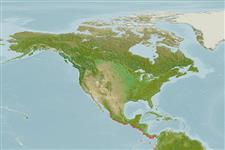Environment: milieu / climate zone / depth range / distribution range
Ecologia
marino demersale; distribuzione batimetrica 0 - 8 m (Ref. 57883). Tropical
Distribuzione
Stati | Aree FAO | Ecosystems | Presenze | Point map | Introduzioni | Faunafri
Eastern Pacific: Mexico and El Salvador.
Size / Peso / Age
Maturity: Lm ? range ? - ? cm
Max length : 6.1 cm SL maschio/sesso non determinato; (Ref. 57883)
Short description
Morfologia | Morfometria
Raggi dorsali molli (totale): 64-72; Raggi anali molli: 49 - 54; Vertebre: 39 - 41. The species is distinguished by the following characters: vertebrae 11 + 28-30 = 39-41, dorsal fin rays 64-72, anal fin rays 49-54; outer pseudoclasper is broad, wingshaped with single curved supporter; inner pseudoclasper with three lobes, consisting of a branched supporter, anterior branch curved and long, posterior branch short, and a thick fleshy lobe in between;
penis with no abrupt change in thickness; opercular spine with single, sharp tip in small specimens and bi- or tri-furcated in specimens > 45 mm SL; scale patch on cheeks is broad, with 8-10 vertical scale rows; otolith length: height ratio 2.2 (Ref. 57883).
Apparently lives on rocky bottoms (Ref. 57883).
Life cycle and mating behavior
Maturità | Riproduzione | Deposizione | Uova | Fecundity | Larve
Møller, P.R., W. Schwarzhans and J.G. Nielsen, 2005. Review of the American Dinematichthyini (Teleostei: Bythitidae). Part II. Ogilbia. aqua, J. Ichthyol. Aquat. Biol. 10(4):133-207. (Ref. 57883)
IUCN Red List Status (Ref. 130435)
Threat to humans
Harmless
Human uses
Informazioni ulteriori
Nomi ComuniSinonimiMetabolismoPredatoriEcotossicologiaRiproduzioneMaturitàDeposizioneSpawning aggregationFecundityUovaEgg development
Age/SizeAccrescimentoLength-weightLength-lengthLength-frequenciesMorfometriaMorfologiaLarveDinamica popolazioni larvaliReclutamentoAbbondanzaBRUVS
BibliografiaAcquacolturaProfilo di acquacolturaVarietàGeneticaElectrophoresesEreditarietàMalattieElaborazioneNutrientsMass conversion
CollaboratoriImmaginiStamps, Coins Misc.SuoniCiguateraVelocitàModalità di nuotoArea branchialeOtolithsCervelliVista
Strumenti
Special reports
Download XML
Fonti Internet
Estimates based on models
Preferred temperature (Ref.
123201): 24.3 - 29.1, mean 26.9 °C (based on 190 cells).
Phylogenetic diversity index (Ref.
82804): PD
50 = 0.5000 [Uniqueness, from 0.5 = low to 2.0 = high].
Bayesian length-weight: a=0.00389 (0.00180 - 0.00842), b=3.12 (2.94 - 3.30), in cm total length, based on all LWR estimates for this body shape (Ref.
93245).
Trophic level (Ref.
69278): 3.3 ±0.5 se; based on size and trophs of closest relatives
Fishing Vulnerability (Ref.
59153): Low vulnerability (10 of 100).
